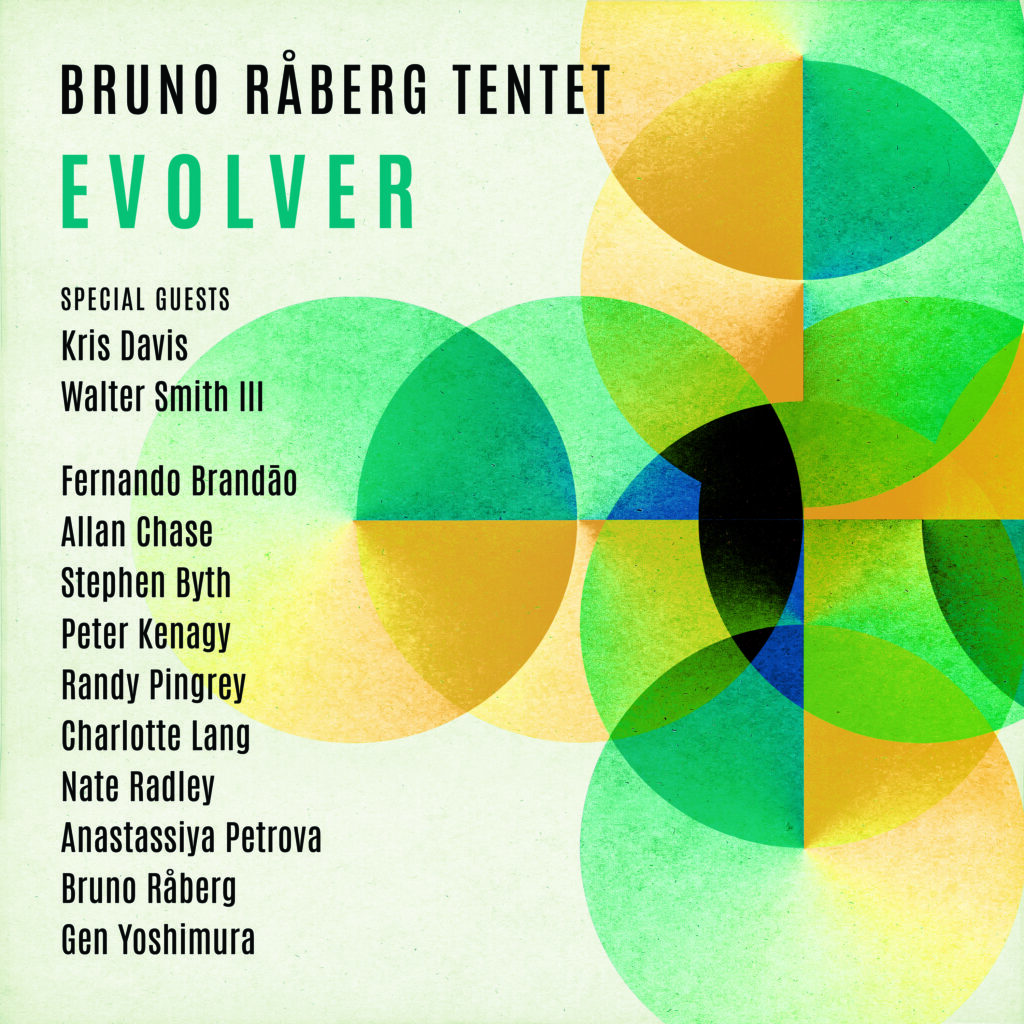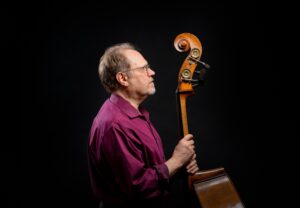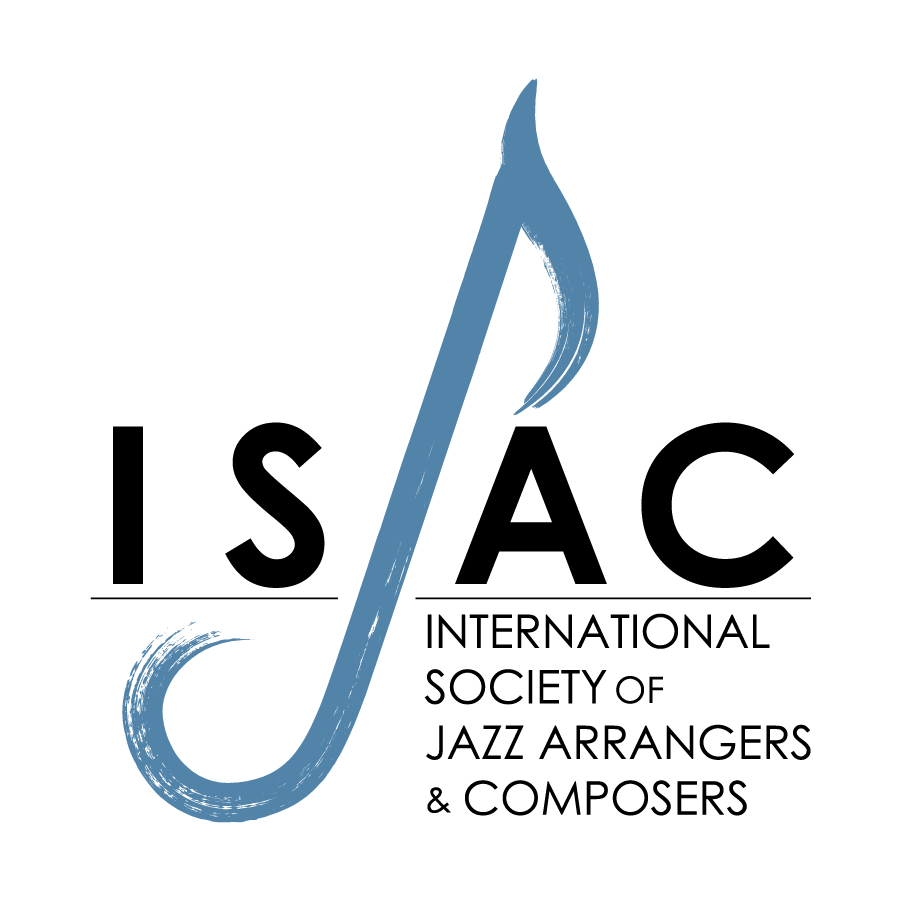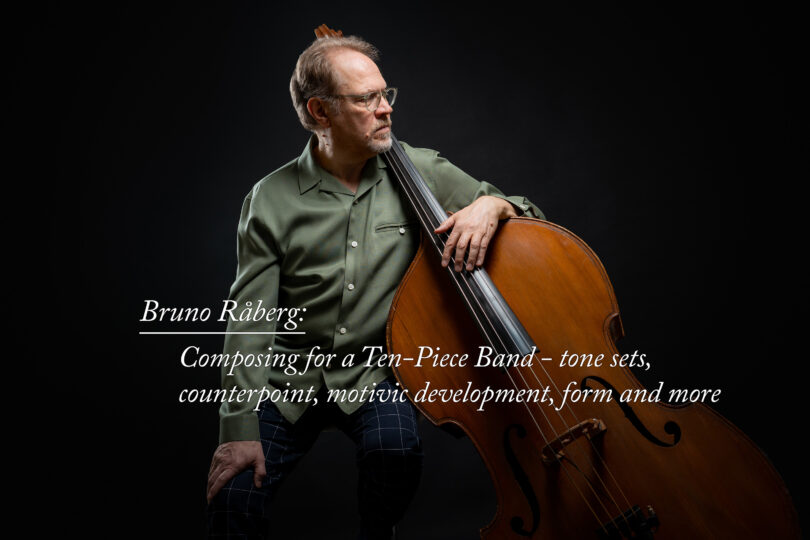First of all, I’d like to thank JC Sanford for inviting me to write this article. I’m very honored to get to share my composition ideas with ISJAC community.
On my recent release, Evolver, I composed for a ten-piece band (see personnel below).
I chose to work with 6 horns because I can get the full sound of a large ensemble as well as the flexibility of a small group, the latter being especially evident during solos. This setting enables easy communication between the rhythm section and the soloist, more like that of a small group than that of a big band where the soloist tends to be upfront and sometimes far from the rhythm section. I like having the flute on top as part of the overall identity, and the bass clarinet with its reedy sound is perfect for doubling lines with the double bass. The bass clarinet can also go into the high register to be part of the upper horns, in which case the trombone can fill the bottom role. Another reason for 6 horns is that I like to write 6-note voicings. Then, if the bass plays the root instead of the bass clarinet, I can actually write 7 note voicings which I find very exciting since they use all the notes in the diatonic 7 note scales. A lot of inspiring options here.
The piece I will talk about here is called “Erebus”. In addition to the ten piece band it features pianist Kris Davis and tenor saxophonist Walter Smith III.
The groove for the piece is an even 8th note, very open feel in 4/4. The bass line is a simple two-bar ostinato dictating the harmony, and is the basic underpinning rhythm for the piece.

Overall Form Structure
This piece was not originally written as a lead sheet. It unfolded as I was composing for the 10-piece band. The overall song form is A-A’-B. The A sections are roughly 24 bars and the B section is 8 bars. The B section is a contrasting four-bar vamp using only parallel major triads. I like to emphasize contrast between A and B sections. Inspired by the intro from Wayne Shorter’s composition “Witch Hunt”, I decided to use the B section as an intro because of its contrast to the A section. It has a major key, bright sound ,versus the A section’s darker colors. (See except below) “Erebus” comes from Greek mythology and stands for “descending into darkness,” and I get that feeling going from the intro to the A section.
Here’s a graphic outline of the overall form structure.

Composing with Tone Sets
The main melodic and harmonic material in this piece is based on a series of tone sets. I like to use this as a way of breaking out of the typical diatonic harmonic environment and creating new, fresh and inspiring sounds. I find that as the piece progresses, I go more and more to where my ears/imagination take me, rather than adhering too strictly to the tone sets which can inhibit the creative process. Each composition makes its own “rules.” That said, sometimes, as the composition progresses, I mix in more typical diatonic and jazz harmony.
These are the main Tone Sets I used for creating the melodic material and some of the harmony as well. The roots form an augmented triad and thus a symmetric circular pattern. I’m juggling these tri – and tetra chords throughout the composition.

Melodic Construction
Most of the melodic materials were derived from the above tone sets. I use a basic melodic motive and what I call a “growing” melody. With each repetition the melodic motive is developed and varied as illustrated below. The tone sets are transposed and used extensively for call & response contrapuntal conversation.

The C section
In the context of song form, this is the short bridge, tag or B section. It provides release and contrast to the A section. In general, I like to create rich-sounding voicing by blending major and minor triad structures. As mentioned earlier, I decided to use this as an intro as well but in a different key.

Harmony
The harmony in this piece was created primarily to support the melodic content, and falls into the category of semi-modal. For the clearest outline of the basic harmony and song form, it is best to look at the solo section, which is also the basic format for both A sections of the piece.
I deliberately left the harmonic instructions very open for the soloists (see below.) It is based on two pedal points, Ab and A. I notated the tri-chords from the melody as a guide for the soloists. Both bass pedals ended up being played mostly around minor modes. The last 4 bars of A is a turn-around and on the repeat there’s an additional 4 bars with a more defined F7 alt. chord. The form would be best described as:
A – B (1st ) A – B (2nd ) – C
In the B sections there are three parallel chords with syncopated punctuations. The voicings are two stacked 5ths based on the roots, A – Db – G. Since the root – 5th – 9th voicings leave it harmonically very open, the soloists can choose what chord qualities they would like apply. The A chord tended to minor, and the Db to major.

Interlude
The main focus of the interlude counter line writing. It can be broken down into three lines and some chordal pads. Line 1 is played by flute, clarinet and piano, line 2 by alto sax and flugel horn and line 3 by trombone, bass clarinet and bass. Line 3 is really a bass line whereas lines 1 and 2 are melodic. The harmonic material in lines 1 and 2 are using the tetra chords with two different tetra chords super imposed to create polytonality. The bass line, line 3, rotates within the augmented 3rds circle, Ab-C-E, the roots of the tetra chords. The whole section builds in intensity by increased dynamics, thicker orchestration and development of faster rhythms. The goal of the section is to launch into and to set up the solo section. When writing interlude sections I find it crucial to have a resolution and goal in mind.
- The first melodic statement is in Line III played by bass clarinet and bass. This is the same melodic line as the initial statement at letter A.
- Line 3 starts, the bass line which rotates within the augmented 3rds circle, Ab-C-E with chromatic pickup notes and a syncopated groove.
- Line 2 enters first in alto sax joined by flugel horn in bar 10. This line first uses tetra chords I and II then in bar 10 sticks with tetra chord III through bar 14.
- Line I enter played by flute, clarinet and piano. It uses tetra chords II and then III in bars 10 through 15 tetra chord I.
- Here all three lines are played together. Line 1 – tetra chord I, line 2 – tetra chord III – line 3 – rotates between Ab-C-E as roots.


CODA
The coda comes directly after the drum solo. I chose to call it a coda but it is both the recapitulation and the head-out. The first two bars are exactly as the first two of letter A (exposition) but have a different harmonic environment. There is development of the melody and harmony, with counter lines and call & response between the melody, harmony and bass line.
- Melody superimposes an Ab major sound over the B tonality in the bass, suggesting polytonality.
- Melody overlays a B Phrygian sound over the B minor tonality.
- Transitional material follows, from B to G tonality, with contrary motion between the bass (root & 5th) and the chords (chromatic parallel triads in 2nd inversion).
- Repetition of motives from bars 1-2 occurs, with development and transposed down a major third to G tonality.
- Rhythmic figures continue, with displacement and variation through bars 10-14.
- Melodic lines use the tetra chords, freely playing with some retrograde versions of previous motives.
- Unison ending with flute, bass clarinet, piano and bass using the 3 original tri-chords. The last note Bb circles back to tri-chord I and offers a sense of resolution.
- Final chord composed of seven stacked perfect 5ths C-G-D-A-E-B-F#-C#, with the last C# placed an octave down. This creates and sense of resolution but still with some ambiguity.


A closer look at bars 12-13-14 from the Coda
- Constant structure using a semi-cluster voicing in the E dorian mode.
- Stepwise voice leading resolving into two pairs of 6ths: B-G# and Eb-C, keeping the E-B perfect 5th in the bass.
- Sometimes I compose chord structures by stacking interval pairs. It creates new, interesting sounds that have some sense of symmetry to them. Here I use several pairs of 6ths.
- The G-Eb on top creates a sense of harmonic resolution since, together with the C-G perfect 5th in the bass it suggests a C minor tonality.

Conclusion
As I am analyzing, in this case my own music, I’m reminded of what a truly complex activity composing is. I envision a pendulum that in a most irrational way swings back and forth between intuition and theoretical thinking, between following what you are hearing in your musical imagination and drawing on theoretical techniques and concepts. One can’t live without the other and in the end it’s what resonates deeply within you that is your guiding star.
Here is the full track with the score

The personnel for Evolver is:
Fernando Brandão – flute/alto/bass flute
Allan Chase – alto/soprano/baritone sax
Stephen Byth – tenor sax/clarinet
Peter Kenagy – trumpet/flugel horn
Randy Pingrey – trombone
Charlotte Lang – bass clarinet
Nate Radley – guitar
Anastassiya Petrova – piano, B3 Organ
Bruno Råberg bass
Gen Yoshimura -drums
Special guest are pianist Kris Davis and Walter Smith III on tenor sax.
Evolver is available on BandCamp brunoraberg.bandcamp.com, my website www.brunoraberg.com and all streaming platforms.
About the Author:
 Professional bass player, composer, and educator Bruno Råberg is a professor at Berklee College of Music in Boston where he teaches jazz composition, ensembles and bass at the undergraduate and graduate level, and travels worldwide as a clinician and performer.
Professional bass player, composer, and educator Bruno Råberg is a professor at Berklee College of Music in Boston where he teaches jazz composition, ensembles and bass at the undergraduate and graduate level, and travels worldwide as a clinician and performer.
His independent record label, Orbis Music Records, includes stellar artists such as Chris Cheek, Ben Monder, Donny McCaslin, Mick Goodrick, Bob Moses, and Bruce Barth. His latest release, Evolver, showcases his talent for composing large-scale works, featuring a tentet with notable musicians like Kris Davis, Walter Smith III, Allan Chase, Nate Radley and others.
Since coming to the U.S. from his native Sweden in 1981, he has made 14 recordings as a leader featuring all original compositions, about 50 as a sideman, and has performed/recorded with numerous world-class artists including Kris Davis, Jerry Bergonzi, George Garzone, Kenny Werner, Sam Rivers, Tony Malaby, Terri Lyne Carrington, Jim Black, Matt Wilson, Ted Poor, Bob and Mike Mainieri. For scores, tour schedule, etc., visit him online at brunoraberg.

